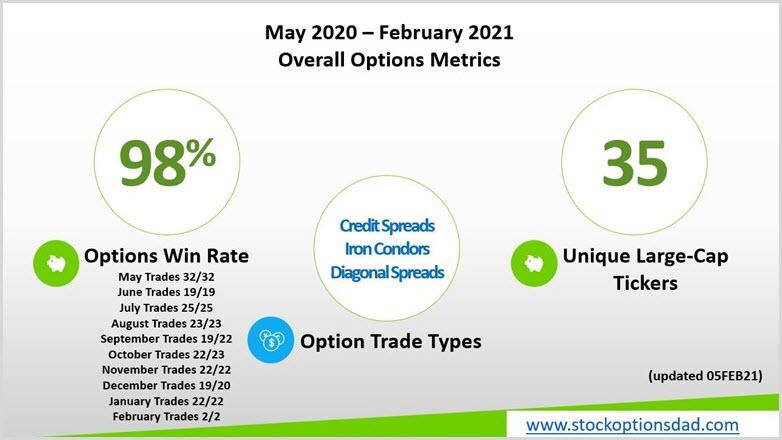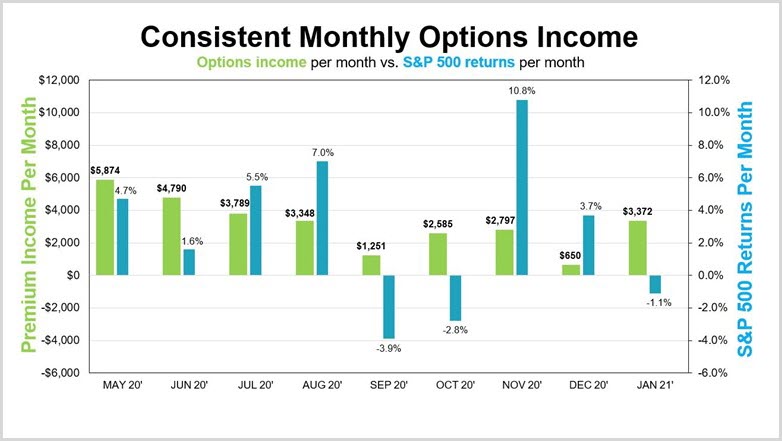Generating consistent monthly income while defining risk, leveraging a minimal amount of capital, and maximizing return on capital is the core of options trading. Options enable smooth and consistent portfolio appreciation and consistent monthly income without guessing which way the market will move. Over the past 9-plus months (May 2020 – February 2021), 203 trades were placed and closed. A win rate of 98% was achieved with an average ROI per winning trade of 7.8% and an overall option premium capture of 83% while outperforming the S&P 500. The performance of an options-based portfolio demonstrates the durability and resiliency of options trading to drive portfolio results with 50% of the portfolio held in cash, thus substantially less risk. The options-based approach circumvented the September, October, and January sell-offs while outperforming the S&P 500, posting returns of 47.6% and 43.7%, respectively (Figures 2-6). Following a well-defined set of options rules are essential for long-term successful options trading. Continuously reflecting and refining these rules is also essential to ensure continuous improvement via lessons learned with supplemental rules (Figure 1).
Options Trading Framework - 10 Essential Rules
A set of trading fundamentals must be followed to run an options-based portfolio successfully. Specifically, position-sizing, sector diversity, maximizing the number of trade occurrences, and risk-defined strategies are some notable areas that traders need to heed for long-term successful trading.
To run an options-based portfolio effectively and successfully over the long-term, the following option trading fundamentals must be exercised in every trade. Violating any of these fundamental rules will jeopardize this strategy and possibly negate the effectiveness of this approach on the whole. Below are 10 option trading rules that provide a basic framework of options trading to maintain discipline and systematic trading mechanics.

Figure 1 – 10 rules for long-term successful options trading as demonstrated throughout these performance metrics
-
1. Trade across a wide array of uncorrelated tickers
2. Maximize sector diversity
3. Spread option contracts over various expiration dates
4. Sell options in high implied volatility environments
5. Manage winning trades
6. Use defined-risk trades
7. Maintains a ~50% cash level
8. Maximize the number of trades, so the probabilities play out to the expected outcomes
9. Place probability of success in your favor (delta)
10. Appropriate position sizing/trade allocation
Option Rules - Additions and Refinements
Continuously reflecting and refining the basic framework of options trading is encouraged to ensure continuous improvement and adjusting for lessons learned. The additional guidance will strengthen the initial set of rules to drive better outcomes over the long-term.
-
1. Avoid earnings-related events (these events can routinely cause strike prices to be heavily challenged and/or breached post earnings)
2. Avoid concurrent option trades on the same underlying ticker (if concurrent trades are placed, ensure an adequate gap between expiration dates and use different strikes)
3. Avoid strike widths wider than ~$5 (rolling trades becomes more feasible and will allow better opportunities for closing trades)
4. Use technical analysis to aid in trade selection such as RSI and Bollinger bands (this can help identify the trade type to execute, such as iron condors, put spreads and call spreads)
Potential Landmines and Anomalies
Following the 10 basic rules with the supplemental guidance cannot guarantee flawless results in the options trading arena. One of the biggest threats to options trading is unforeseen black swan events that may jeopardize any put side options that are in play at the time a drastic market sell-off occurs. Another unforeseen event is regulatory surprises that impact a specific stock or sector. These include regulatory violations and regulatory threats by government officials. Social media stocks have routinely been targets of regulatory action, banks were heavily constrained by regulatory action for years, and recently foreign governmental intervention can weigh heavily on a company (Alibaba’s recent extreme volatility).
Options Results
When adhering to the basic 10 rules and layering in the supplemental guidelines, long-term success can be achieved, as demonstrated by a 98% win rate. When compared to the broader S&P 500 index, an options-based portfolio has outpaced the S&P 500 returns through mid-February 2021 with substantially less risk due to holding ~50% of the portfolio in cash (Figures 2-5).
Overall, from May 2020 through mid-February 2021, 203 trades were placed and closed. An options win rate of 98% was achieved with an average ROI per trade of 7.8% and an overall option premium capture of 83% while outperforming the broader market through the September, October, and January declines (Figure 2).

Figure 2 – Overall options-based performance compared to the S&P 500 from May 2020 – January 31st, 2021

Figure 3 – Overall option metrics from May 2020 – February 5th, 2021

Figure 4 – Overall option metrics from May 2020 – February 5th, 2021

Figure 5 – ROI per trade over the past ~220 trades
Consistent Income Despite September, October, and January Declines
The September, October, and January declines provide a great opportunity to demonstrate the durability and resiliency of an options-based portfolio. A positive $1,251 return, a positive $2,585 return, and a positive $3,372 return for the options portion of the portfolio was achieved in September, October, and January, respectively (Figure 6). Generating consistent income without guessing which way the market will move is the key to options trading.

Figure 6 – Generating consistent income despite negative returns for the S&P 500 index in September, October, and January
Conclusion
Following a well-refined set of options, rules is essential for long-term successful options trading. Continuously reflecting and refining these rules ensures continuous improvements are layered into your trading strategy. The additional supplemental rules will strengthen the core rules to drive better outcomes over the long-term (i.e., avoiding earnings-related events and using technical analysis).
The September, October, and January declines provide a great opportunity to demonstrate the durability and resiliency of an options-based portfolio. Positive returns were generated in all three negative months for the overall market, generating consistent income without guessing which way the market will move.
An options-based approach provides a margin of safety while circumventing the impacts of drastic market moves as well as containing portfolio volatility. Despite market volatility, consistent monthly income has been generated while outpacing the S&P 500 with 50% of the portfolio in cash.
An options-based portfolio provides the agility required to mitigate uncertainty and volatility expansion while circumventing market declines. Using the 10 rules as a foundation along with the supplemental rules will drive consistent options results. Heed all options trading rules; any violation of these rules may result in unmitigated portfolio damage with the potential for losses.
Thanks for reading,
The INO.com Team
Disclosure: The author holds shares in AAPL, AMZN, DIA, GOOGL, JPM, MSFT, QQQ, SPY and USO. The author has no business relationship with any companies mentioned in this article. This article is not intended to be a recommendation to buy or sell any stock or ETF mentioned.

To be worthwhile of the time needed to make all the trades, the committed fund must be sufficient to be worthwhile for the time spent when compared to the return of the SP (requiring ~0 time).